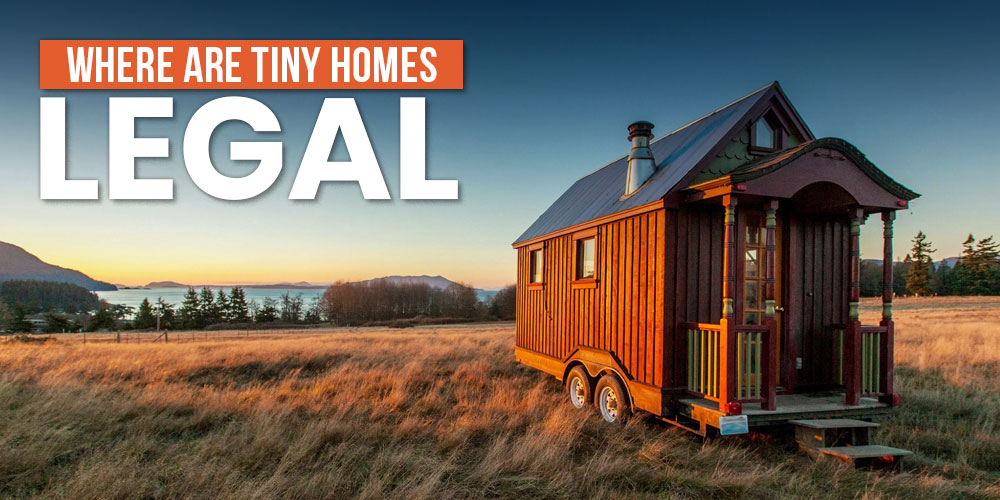
NAVIGATION
The tiny house movement is fairly new, so tiny homes are not yet legal everywhere. If you are feeling inspired to try tiny living for the first time, you’re probably wondering where tiny houses are legal, and if you can start building where you live.

Hi, I’m Ryan
I’ve learned a lot about tiny house laws in the past 10 years in the tiny house community. I’ve done a ton of research regarding where tiny homes are legal and want to share that with you.

Where Are Tiny Homes Legal?

In the last few years, the tiny house movement has grown immensely. During my time as a tiny houser, I’ve seen firsthand the way that the tiny home movement has changed people’s lives.
It’s given people an alternative way to live, and lawmakers are catching onto to this new trend that people love! The more time goes by, the more tiny houses are becoming legal all over the world.
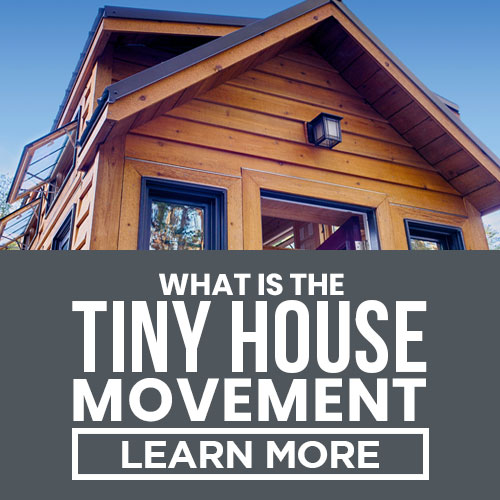 It may seem weird that tiny houses aren’t legal everywhere by now. I mean, what harm can a 300-square-foot house really do to society? However, it makes sense when you zoom out and consider the bigger picture of what housing laws were created for.
It may seem weird that tiny houses aren’t legal everywhere by now. I mean, what harm can a 300-square-foot house really do to society? However, it makes sense when you zoom out and consider the bigger picture of what housing laws were created for.
Housing laws are created with the intention of keeping homeowners safe and happy, and keeping each municipality neatly organized. City planning is an entire ordeal that can be insane when you really start getting into the weeds of it. Housing, zoning, and building laws have to be tight.
Since the tiny house trend is so new, the allotted dimensions built into traditional housing laws don’t always naturally allow for tiny houses. To know if a tiny house is legal where you live, look into the building and zoning laws in your specific state.
What Are My State’s Building And Zoning Laws?

In a nutshell, building laws are the rules and regulations centered around things like house dimensions, safety features in a home, how many doors or sets of stairs you can have, and basically anything that has to do with the actual building or the way the dwelling was built.
Zoning laws, on the other hand, are laws specifically geared towards where you’re allowed to build or park your dwelling. Many states have not developed specific building and zoning laws for tiny houses yet. However, many other states have adopted a version of Appendix Q, which specifically addresses the legality of tiny homes.
You can find your states individual building and zoning laws with a simple Google search of “state building laws” or “state zoning laws”.
What Is Appendix Q?

The creation of Appendix Q was a huge game changer in the tiny house community. Basically, Appendix Q is an addition to the International Residential Code that was approved for inclusion in the 2018 version of the IRC.
Appendix Q was the first ever to create specific requirements for tiny houses. However, not all states use it in the same way or at all.
In some states, individual cities and counties use Appendix Q, but not all. Some states have adopted the full appendix into their own state codes, while some have decided not to include the IRC in their building codes at all. Check out our full guide to using Appendix Q:
Is It Legal To Live In A Tiny House?

With anything involving legality, it’s really never black and white. Knowing whether or not it’s legal to live in a tiny house not only depends on where you live, it also depends on what you mean by “live in a tiny house.” This has more possible meanings than you may initially realize.
Ask Yourself These Questions
- Is my tiny house my primary home?
- Do I want to travel in my tiny home?
- Is my tiny house an addition to my main home?
- Is my tiny house a temporary vacation home?
- Is my tiny house a guest house?
- Is my tiny house a non-living space (like a studio)?
- Am I using my tiny house as a rental property?
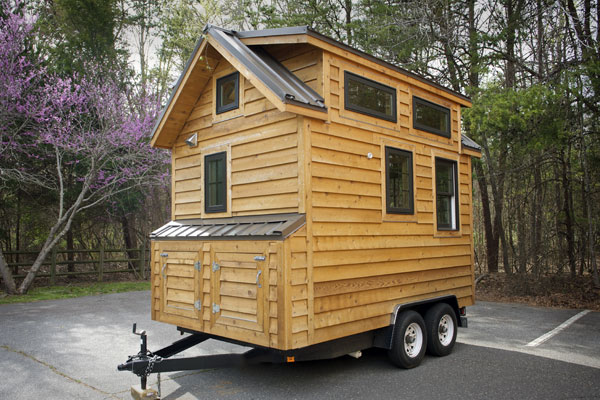
Different building laws exist not only in different areas, but for different types of dwellings and uses for dwellings. The main differentiation that comes up over and over again is that states often have very different laws for tiny homes on wheels than they do for tiny homes on foundation.
States typically classify tiny homes and THOWs separately. It’s pretty common to see tiny homes on foundation classified as a residential dwelling while tiny homes on wheels are classified as recreational vehicles.
It may be the case that it’s legal to make a tiny house on foundation your primary house but illegal to live full time and travel in your tiny house on wheels. Or it may be that you can use a tiny home as an accessory dwelling unit in your yard, but are not allowed to live in it as your primary dwelling.
To decipher if it is legal to live in a tiny house where you live, you need to know the way your state, county, and city classifies your specific type of tiny home. I’ve spent a lot of time reading these kinds of building and zoning laws, and have created a directory to give you the information you need.
If you still feel like you’re missing some key info, try doing some research on your own about the building laws in your area. If you don’t know where to begin, just start with a simple Google search.
Include These Questions In Your Search
- Does my state use Appendix Q for tiny homes?
- Does my state use the IRC 2018 version?
- Are tiny homes on foundation legal in my state?
- Are tiny houses on wheels legal in my state?
- Are accessory dwelling units legal in my state?
- Building laws in my state, county, city
- Zoning laws in my state, county, city
- Recreational vehicle regulations in my state
- Municipal codes in my state
- Tiny house news in my state, county, city
Where Can I Put My Tiny House?
Zoning laws are entirely their own can of worms. Again, where you can legally put your tiny house is going to depend on where you live and how you plan to use your tiny home. I bet you are seeing the recurring theme here!
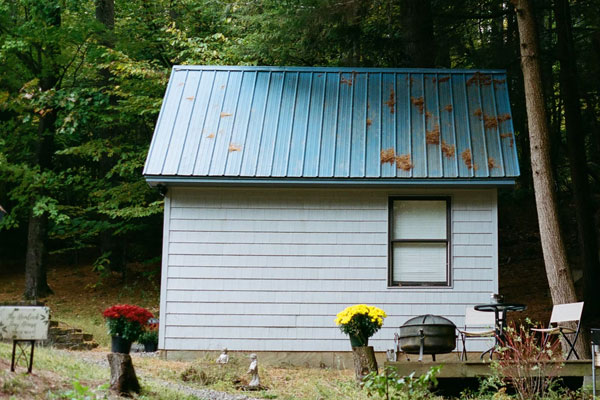 If you have a tiny house on foundation, it’s going to be in your best interest to look into the residential laws for traditional houses in your local jurisdiction and investigate the legal dimensions where you live. Look for residential codes for traditional dwellings and single or multi-family dwellings.
If you have a tiny house on foundation, it’s going to be in your best interest to look into the residential laws for traditional houses in your local jurisdiction and investigate the legal dimensions where you live. Look for residential codes for traditional dwellings and single or multi-family dwellings.
Basically, you should hunt for how small of a dwelling you can put on your land, how many dwellings you can put on your land, and, if your tiny house is an accessory, how far apart your tiny home needs to be from your primary dwelling.
If you have a tiny house on wheels, placement is trickier. The first thing you need to do is decipher how your state, county, and city classifies THOWs. If they classify them as a traditional dwelling, the same laws will apply to your THOWs that apply to your tiny house on foundation. This is, unfortunately, not the case in many states.
It’s much more common for a state to classify a tiny house on wheels as a recreational vehicle or travel trailer than a traditional dwelling. If this is the case, you’ll need to look into where you can legally park an RV or travel trailer in your area.
Is It Legal To Travel The U.S. In A Tiny Home?

Unfortunately, it gets even more tricky on the road. As you travel and cross borders into different cities, different states, or different countries, you’re going to need to adapt to the laws of your new location. It may be that you can park your RV on a friend’s land for a month in one state, but have to stay at an RV park in another.
 My best advice for navigating this is to use the power of the internet. Meaning, do exactly what you’re doing by reading this blog post. I’ve done a ton of traveling in my day, but my work life tends to keep me pretty stationed in my home in North Carolina week to week.
My best advice for navigating this is to use the power of the internet. Meaning, do exactly what you’re doing by reading this blog post. I’ve done a ton of traveling in my day, but my work life tends to keep me pretty stationed in my home in North Carolina week to week.
However, there are a ton of nomadic bloggers, vloggers, and Youtubers out there who have mastered the art of life on the road, and have learned to do it legally. I would venture into this kind of content to learn more about where you can park your tiny house on wheels state to state.
Can I Put A Tiny House In My Backyard?

If you’re wanting to know if it’s legal to put your tiny house in your backyard, you probably aren’t planning to use it as your primary house. To know whether or not it’s legal to add a tiny house to your property depends on the laws for accessory dwelling units that apply to your state.
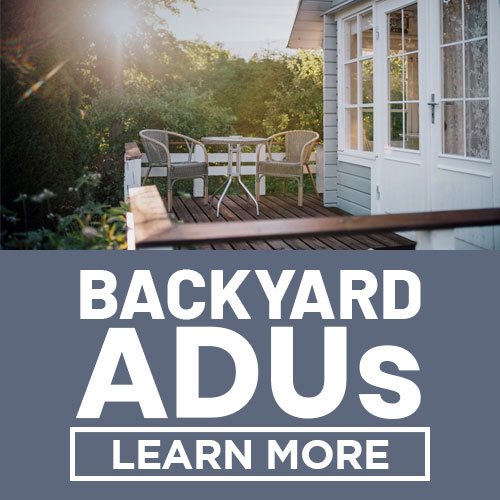 Again, poking around online to find the building, zoning, and residential laws for your specific state, county, and city is the best way to go to decipher if ADUs are legal in your area. Additionally, look into what requirements exist for building an ADU where you live.
Again, poking around online to find the building, zoning, and residential laws for your specific state, county, and city is the best way to go to decipher if ADUs are legal in your area. Additionally, look into what requirements exist for building an ADU where you live.
Similar to all kinds of tiny homes, ADUs have become way more popular in the last five years for uses like home offices or studios, living spaces for relatives, or rental properties. However you plan to use your ADU, you want to make sure it’s allowed before you pour money, time, and energy into building your tiny home.
One way to make sure you know what’s allowed is to consult experts that know more than you. You can call a local government official to get more information on building codes in your jurisdiction.
Or, better yet, call a local building company that produces tiny homes and ADUs. Building companies help customers navigate building codes every day and are experts on the codes in the areas they serve.
Which States Allow Tiny Houses?

Again, every single state is different when it comes to where tiny homes are legal. Some states march to the beat of their own legal drum, some have adopted Appendix Q to centralize their tiny house laws, and others have yet to really address tiny homes in their building codes at all.
Most Tiny House-Friendly States
These states are ahead of the game when it comes to the legality of tiny homes. Many of them have created some tiny house specific laws of their own that make life much easier for those who want to live tiny:
States Most Friendly To Tiny Houses
- California
- Colorado
- Florida
- Georgia
- Hawaii
- Idaho
- Maine
- Montana
- New Hampshire
- New York
- North Carolina
- South Carolina
- Oregon
- Virginia
- Washington
Least Tiny House-Friendly States
These states are a little behind on the tiny house trend. They still use building codes that are extremely limiting to tiny homeowners. Hopefully, these states will do more for the tiny house movement in the near future!
States Least Friendly To Tiny Houses
- Iowa
- North Dakota
- Ohio
- West Virginia
Are Tiny Houses Legal In My State?
Like I’ve said above, each state is really its own can of worms in terms of what is or is not allowed in the state. Each sets its own building codes and regulations.
Is Your State Tiny House Friendly?
The color key below will help you quickly determine if your state is tiny house friendly or not.
Very Friendly
Kind Of Friendly
Not Too Friendly
CLICK TO JUMP TO YOUR STATE
Alaska
Arizona
Arkansas
California
Colorado
Connecticut
Delaware
Florida
Georgia
Hawaii
Idaho
Illinois
Iowa
Kansas
Kentucky
Louisiana
Maine
Maryland
Massachusetts
Michigan
Minnesota
Mississippi
Missouri
Montana
Alabama
What’s tricky about Alabama is that it has yet to develop or claim a statewide building code. This means that implementation of building and zoning codes is managed independently by each county or city.
Alaska
In Alaska, Appendix Q from the 2018 version of the IRC is used in many cities and counties, but not all of them.
Arizona
The legality of tiny homes in Arizona truly depends on which city or county you live in. Some are much more tiny house-friendly and have their own codes, while others are more restrictive.
Arkansas
When it comes to tiny homes on foundation in Arkansas, some cities and counties use the 2018 IRC and Appendix Q. However, it’s harder to live full time in a tiny house on wheels in Arkansas, due to their RV laws.
California
California is vast and diverse. Tiny house laws are regulated by the local jurisdictions in the state. With 58 different counties, it’s essential that you check the rules, zoning laws, and building codes before building a tiny house in California, but many areas welcome tiny housers.
Colorado
Like in many states, Colorado tiny house laws vary from city to city. Depending on the city’s zoning restrictions, there may be different rules and determinations on different types of tiny homes and their uses. Most jurisdictions are fairly accommodating to those who want to live tiny.
Connecticut
Connecticut uses Appendix Q in its state building codes for tiny houses on foundation in most cities and counties. Tiny homes on wheels follow the RV laws in Connecticut.
Delaware
Delaware uses Appendix Q at a statewide level for tiny houses on foundation. Tiny houses on wheels are categorized differently.
The State of Delaware classifies mobile properties based on size, not explicitly by feature. This means that the size of your tiny house is going to be what determines all of the building laws and codes that apply to your tiny home on wheels through the Delaware Department of Motor Vehicles.
Florida
When it comes to tiny houses on foundation, Florida has adopted Appendix Q into its Florida Building Code, 7th Edition, Residential. As far as tiny homes on wheels are concerned, finding land for a tiny house in Florida is challenging, but many RV parks are becoming tiny house friendly.
Georgia
Georgia has adopted Appendix Q at a statewide level for tiny homes on foundation. When it comes to tiny homes on wheels, the Georgia Department of Transportation (GDOT) regulates these vehicles for title and licensing purposes through the county’s vehicle licensing agency.
Hawaii
Hawaii has adopted Appendix Q at a statewide level for tiny houses on foundation. According to the Hawaii Statewide Traffic Code 291C tiny homes on wheels are classified as house trailers by the State.
Idaho
Idaho was the first state to fully adopt Appendix Q. They have also added an additional appendix titled Appendix V for Tiny Homes into their own residential code for tiny houses on wheels.
However, the state of Idaho also has its own code through the Division of Building Safety that addresses regulations surroundings tiny houses and has additional rules for full-time living in tiny houses on wheels.
Illinois
Illinois leaves the legality of tiny houses up to its individual cities and counties.
Indiana
Indiana has fully adopted Appendix Q for tiny houses on foundation. They also have their own law called the Log Cabin Rule that makes it much easier for homeowners to live in a tiny house, regardless of size. For tiny houses on wheels, homeowners must follow the laws for RVs set by the state.
Iowa
It’s pretty difficult to live tiny in Iowa because the state uses the 2015 version of the IRC.
Kansas
Defer to individual cities and counties in Kansas to determine what is allowed for tiny homeowners.
Kentucky
Kentucky has added Appendix Q to the Kentucky Residential Code Second Edition, for tiny houses on foundation, making them legal across the state.
Louisiana
Louisiana has adopted Appendix Q across the entire state, making tiny houses on foundation legal in the state of Louisiana.
Maine
Maine is very tiny house friendly. The state has its own set of building and zoning laws specifically for tiny houses. Tiny house building laws in the state changed substantially in March 2020 when LD 1981, An Act Regarding the Regulation of Tiny Homes, was passed. They also have their own building laws for tiny houses on wheels.
Maryland
It’s hard to determine whether or not tiny houses are legal in Maryland. They aren’t explicitly legal in the state, but they aren’t necessarily illegal either. At this time, there is not any official statewide requirements or restrictions on tiny houses in Maryland — they just aren’t really addressed.
Massachusetts
Massachusetts has adopted Appendix Q at a statewide level for tiny houses on foundation. For tiny homes on wheels, it’s more difficult to live full time in the state.
Michigan
In Michigan, the legality of your tiny home depends on the specific county and city you live in. Building codes in Michigan are fairly flexible, but do include statewide regulations
The Home Builders Association of Michigan (HBAM) and the ICC actually published a book together called the “2018 Select IRC Options For Use With The Michigan Residential Code.” This book was created to familiarize tiny home owners with the changes that the 2018 code includes so they can submit them to the enforcing authority for approval.
Unfortunately, the State of Michigan is staying with the 2015 version of International Residential Code, which does not include Appendix Q that legalizes tiny homes on foundation.
Minnesota
Minnesota uses Appendix Q to make tiny houses on foundation legal across the state.
Mississippi
There are currently no laws in place in Mississippi that regulate tiny homes.
Missouri
Defer to individual cities and counties in Missouri to understand if tiny houses are legal where you live.
Montana
Tiny houses are legal in Montana. Montana is right on track when it comes to the legality of tiny homes. In a ruling by the Montana Secretary of State, the Montana Department of Labor and industry has gone the extra mile to recognize tiny houses as their own dwelling category in the section 24.301.154 of the State’s official building code.
Nebraska
The Nebraska State Legislature gives power to local jurisdictions when it comes to what is legal or illegal.
Nevada
In Nevada, cities and counties have the authority to legalize tiny homes.
New Hampshire
New Hampshire uses its own house bill as a statewide regulation, House Bill 588, which legalizes tiny homes on foundation and tiny houses on wheels.
New Jersey
New Jersey uses Appendix Q to legalize tiny houses on foundation.
New Mexico
Tiny houses on foundation are legal in New Mexico thanks to Appendix Q.
New York
New York uses Appendix Q to legalize tiny houses on foundation. As far as tiny homes on wheels go, the New York City metro area doesn’t allow permanent dwelling in RVs or THOWs. However, many more rural locations, especially in upstate New York, welcome THOW living for permanent homeowners.
North Carolina
North Carolina has adopted Appendix Q at a statewide level, legalizing tiny houses on foundation. The classification of tiny homes on wheels is going to depend on the city or county you live in.
North Dakota
Most areas in North Dakota are not tiny house friendly. The North Dakota State Building Code makes it hard to live in a tiny house full time.
Ohio
Tiny houses aren’t technically illegal under the Ohio State Building Code. However, the building laws do not necessarily make it easy to go tiny. They require a minimum of 950 square feet, which is not typical of tiny homes.
Oklahoma
It’s really easy to live tiny in Oklahoma due to the lack of building regulations. Oklahoma has yet to adopt a statewide building code that restricts houses to particular dimensions. As of now, anything goes in the state.
Oregon
Each of the 36 counties in Oregon has its own set of rules, but many individual municipalities are friendly to tiny homeowners. A 2018 amendment to the Oregon Reach Code granted local building officials the authority to relax or waive some state requirements on tiny houses as long as they can do so safely.
Pennsylvania
The Residential Code of Pennsylvania does not mention tiny houses explicitly, but there are several cities and counties that make specific accommodations to the tiny house community in favor of tiny homeowners.
Rhode Island
Tiny homes are legal in Rhode Island, according to RI HB 7352.
South Carolina
South Carolina’s tiny house laws are among the easiest to navigate in the U.S. concerning tiny house builders.
South Dakota
In South Dakota, individual cities and counties make the rules when it comes to tiny house legality.
Tennessee
Some Tennessee municipalities and counties have chosen to opt out of the Building Codes and Zoning Regulations as laid out in the International Residential Code (IRC), but not all of them have done so.
Texas
In true Texas fashion, building laws are not centralized and are independently regulated by each city and county. Whether you can build a tiny house in Texas depends on the city you live in, but there is usually a lot of freedom for tiny homeowners in The Lone Star state.
Utah
The State of Utah has been a little slow to hop onto the tiny house movement. It has yet to centralize regulations that specifically address tiny homes as residential dwellings.
Due to this, a lot of what you’ll need to know when building tiny in Utah comes down to city and county laws and the regulations set by those individual municipalities.
Vermont
Like many other states, Vermont has yet to address tiny houses as a legal dwelling or create statewide laws around their use.
It’s fairly difficult to live in a tiny home on wheels in most of Vermont’s major cities, though, as those areas tend to be stricter with zoning and building laws.
Virginia
Most regions of Virginia welcome tiny houses with local definitions and regulations stating where they are allowed to be parked.
Washington
Recently, Washington adopted new laws to make tiny house living easier and more accessible. The new laws allow local municipalities to approve multi-unit lots for tiny home communities, eliminates any single-family dwelling minimum square foot requirements, adds tiny houses and THOWs to the definition of factory-built housing so they can be included in RV and trailer parks, and clears a regulatory pathway to allow Eco-villages and tiny home communities.
West Virginia
In all honesty, it can get pretty dicey to live full time in a tiny house in the state of West Virginia. It’s already a bit of a feat to get a tiny house on foundation authorized for full time living in the state, let alone residing permanently in a tiny house on wheels.
Wisconsin
It’s not impossible to live tiny in Wisconsin, as many tiny house lovers have found ways around the lack of legal clarity.
The State of Wisconsin does follow a few regulations around tiny homes. Unanimously, tiny houses in Wisconsin must be a minimum of 120 square feet and contain at least one room considered habitable in the long term. After this specificity, most other regulations can get muddy and are extremely contingent upon where you live in the state.
Wyoming
Wyoming uses Appendix Q at the statewide level, legalizing tiny homes on foundation.
Your Turn!
- What steps do you need to take to make sure your tiny house is legal?
- What types of tiny homes are legal where you live?


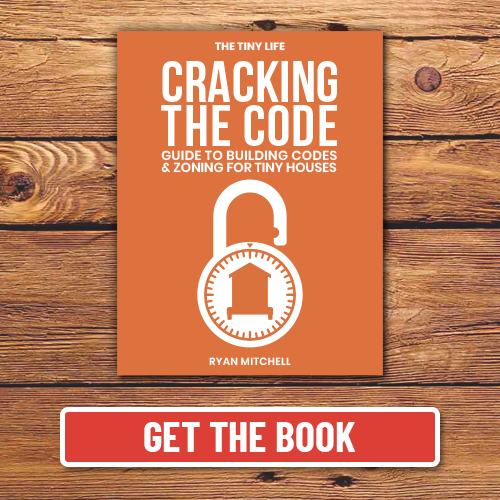




Leave a Reply